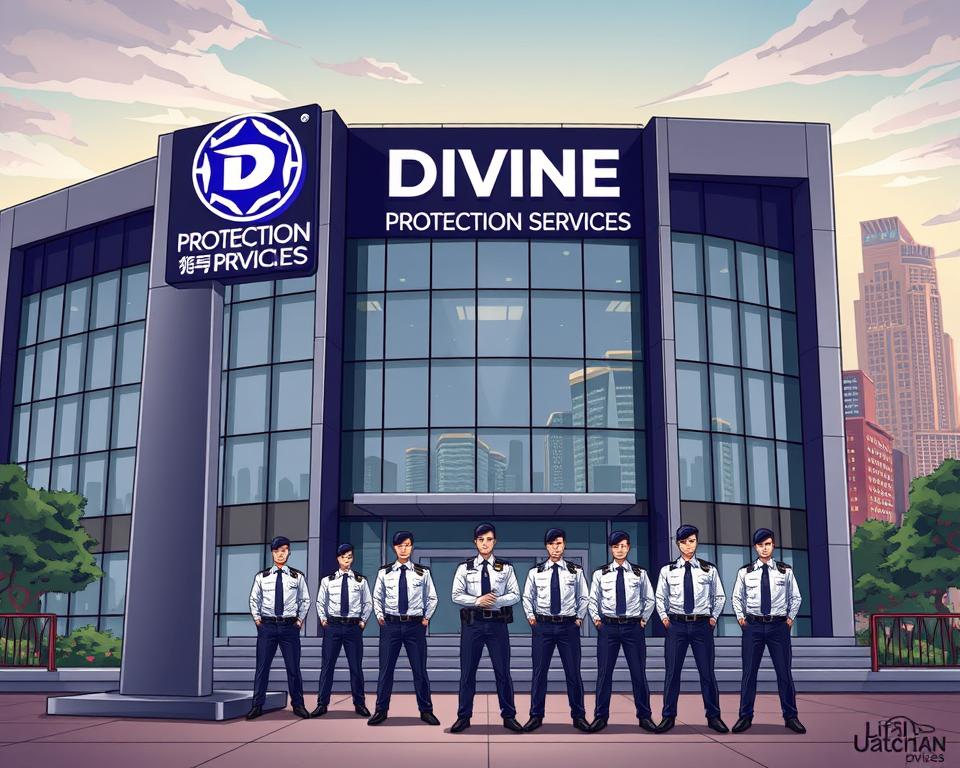Boost Your Project’s Worksite Safety Now
Picture arriving at your worksite later only to find critical gear gone and even equipment items defaced. How soon might obstacles like these derail project schedules and budgets? Job sites regularly house expensive items in unsecured zones, thus leaving them prone to theft. Absent adequate protections, you’re not only endangering materials—you risk everything your team has built.
Thieves often go after locations lacking extensive monitoring, especially after hours. Mobile machinery theft alone costs companies millions each year. Setbacks due to replacing stolen gear and fixing vandalism create stress and surprise bills. But here’s the good news: preventive mall security planning can turn vulnerabilities into strengths.
Divine Protection Services specializes in customized protection strategies for dynamic environments. Their strategies blend advanced technology and field experience to maintain your assets protected. In the following sections, you can learn concrete measures to prevent theft, manage access, as well as keep progress without compromises.
Ready to change how you protect your site? Let’s explore effective solutions designed to merge productivity and strong security.
Grasping Construction Site Security Fundamentals
Every year, vulnerable construction sites experience millions of dollars in losses because of avoidable events. Unsecured zones with high-value gear draw opportunistic thieves, particularly when it’s dark. Let’s break down the main challenges as well as why early action matters.

Where Security Gaps Appear
Open storage containers, unattended materials, as well as poorly lit zones create easy targets. A recent report notes a 40% increase in theft in busy summer months. Common vulnerabilities include:
- Portable generators left overnight
- Visible copper wiring storage
- Insufficient perimeter barriers
Expenses Exceeding Stolen Goods
A single stolen excavator could push project timelines back weeks while insurance claims process. Fixing vandalism frequently costs over $5,000 per case, quickly eating budgets. Workers end up on overtime to compensate—doubling the productivity loss.
Simple fixes like motion-activated lights reduce after-hours breaches by 60%, according to safety studies. Pairing visible cameras with locked gates signals to intruders that risks outweigh rewards.
Addressing these basics first, you set up a robust groundwork for next-level measures. Next, we’ll explore tailoring solutions to your location’s unique needs.
Evaluating Your Unique Job Site Security Requirements
Why certain sites are more at risk than others? All worksites possess specific factors affecting their vulnerability. A comprehensive review of your location’s design, processes, and equipment is essential for crafting defenses that truly work.
Identifying Site-Specific Vulnerabilities
Begin with mapping busy areas and storage locations. Are high-value items sitting in poorly lit spots? Is fencing missing near public thoroughfares? According to one safety guide, blind spots in high-traffic areas lead to 35% of thefts after hours. Fixing these issues promptly avoids future problems.
Think about how storing supplies influences risk. For example, copper wiring piled near temporary gates invites trouble. Similarly, portable gear left exposed in fields invites theft. Site-specific tactics could include:
- Adjusting lighting based on work hours
- Designating locked storage for high-value items
- Reconfiguring entry routes to minimize exposure
A customized safety plan isn’t just about tools—it protects your team’s efforts. Active precautions minimize downtime and protect finances. By focusing on your location’s unique needs, you create a shield that adapts as the job evolves.
Enacting Practical Security Upgrades
Bright perimeter lights serve as more than illumination—they’re the first line of defense. Let’s explore practical upgrades that blend technology with smart design to protect your assets.
Intelligent Lighting Solutions
Motion-activated lights eliminate shadows where intruders hide. A contractor saw a 75% drop in nocturnal security breaches after adding them around storage sections. Add:
- Solar-powered fixtures for remote zones
- Timed operations aligned with work schedules
- Weather-resistant models for durability
Multi-Functional Barrier Solutions
Sturdy fencing does more than mark boundaries—it slows down unauthorized entry. A case study showed chain-link barriers with anti-climb features cut trespassing attempts by 60%. Pick barrier types that:
- Stand up to vehicular impacts
- Allow visibility for patrols
- Have lockable entryways
Prominent signage operates as a wordless guard. Posting “No Trespassing” notices alongside alarm decals deters intruders. One team reported zero thefts after adding multilingual signs near entryways.
Current alarm solutions send live notifications to smartphones. Use them alongside motion-sensing devices and electronic locks for multi-layer security. Have your team conduct weekly inspections to verify device functionality—this little bit of time saves major trouble down the line.
By implementing these measures now, you create a safer environment for workers and equipment. Ongoing revisions ensure your tactics remain strong as the job progresses.
Utilizing Tech to Secure Your Worksite
No longer must you rely just on padlocks and security patrols. Current tech merges innovation with functionality, forming a safeguard that operates while you’re away. Let us review how advanced tech tools defend assets while maintaining workflow efficiency.
Ever-Vigilant Surveillance
Today’s cameras not only capture footage but also analyze it. Pairing 4K video with motion sensors lets them spot unusual activity, like someone lingering near storage containers after hours. A contractor saw an 82% drop in theft by employing setups that ping alerts to smartphones. Available types are:
- Solar-powered units for remote zones
- Weatherproof designs that withstand harsh conditions
- Infrared modes for clear night vision
Continuous recording captures every detail, while motion-activated modes save energy. “Combining both approaches cuts false alarms by 50%,” notes a recent tech report.
Smart Entry, Smarter Control
Access cards make tracking easy without impeding team speed. Scan-to-enter systems log who’s on-site and when—ideal for managing subcontractors. Perks feature:
- Immediate logging for review
- Remote permission updates
- Linking to alarm networks
One project manager shared: “We caught a delivery error fast because our logs showed exactly who accessed the equipment shed.” While guards remain important, tech covers basic monitoring, giving them time to patrol sensitive spots.
These solutions augment human oversight rather than replace it. Uniting conventional techniques and modern tech crafts a defense that evolves alongside your project.
Enhancing Protection Through Divine Protection Services
How recently did your site’s safety strategy adjust to new threats? Divine Protection Services shines by viewing each job as distinct. They kick off with detailed site assessments, tracking risks from material placement to regional crime data. This isn’t cookie-cutter protection—it’s precision.
Advantages of a Collaborative Security Method
Rather than one-size-fits-all fixes, they study your processes and environment. For instance, a highway project needed patrol adjustments according to local pedestrian patterns. Outcome: Six straight months without a theft. Their approach consists of:
- Field assessments by safety engineers
- Custom tech blends (drones + ground sensors)
- Monthly tactic adjustments to match project shifts
Skilled Security Staff and Guard Approaches
Here, guards are more than lookouts—they’re experts in conflict management and technology. One team prevented $12k in losses by spotting suspicious activity near fuel storage. Their multilayer method blends:
- Around-the-clock patrols on varied routines
- Real-time data feeds to mobile devices
- Quick-action emergency exercises
“We slashed vandalism by 91% on sites we protect,” reports a team leader. By merging human insight with AI analytics, they create a shield that thinks ahead.
Steps to Block Unauthorized Entry and Theft
Consider intruders wandering onto your premises undetected. Uncontrolled entry points turn projects into playgrounds for opportunists. A single unlocked gate or poorly timed delivery can invite trouble—but smart planning stops intruders before they strike.
The Importance of Timing and Tracking
Schedule material drop-offs during active hours when teams can supervise. One study found 68% of thefts occur when items sit unattended overnight. Coordinating deliveries with crew availability makes sure items get logged and locked away right away
Locked storage zones with limited access points reduce temptation. Assign specific areas for high-value tools, and use tamper-proof containers. A project manager commented: “Having assigned locations makes it easy to spot missing equipment right away.”
- Limit access to primary gates after hours
- Implement RFID tagging for live equipment monitoring
- Perform surprise checks during shifts
Trained personnel play a key role. Security personnel patrolling edges and verifying credentials effectively deter intruders. Pair their presence with digital logs that record every visitor’s entry and exit times.
Small changes—like adjusting delivery windows or relocating storage trailers—create big barriers against theft. Review protocols weekly to close gaps before they become liabilities. Integrating logistics with security keeps projects timely and cost-effective.
Securing Sites with Full Risk Mitigation
What’s your backup plan if a storm floods your storage yard at midnight? While cameras and fences form your first defense, true protection comes from planning for the unexpected. Combining insurance coverage with emergency protocols creates a safety net that keeps projects moving forward—even during crises.
Insurance Combined with Real-World Planning
Sufficient insurance transforms disasters into controllable setbacks. One contractor avoided $78k in losses after thieves struck—their policy covered replacements without delaying deadlines. Yet, coverage alone isn’t sufficient. Match it with:
- Documented equipment inventories
- Round-the-clock response teams for security incidents
- Weather-responsive evacuation procedures
Drill your plans every quarter. A Midwest crew avoided injuries during a tornado by rehearsing shelter protocols. Their exercises reduced evacuation time by 63% versus nearby job sites.
Modern alarm systems now integrate with emergency notifications. When sensors detect flooding or fire, they automatically alert local responders. This dual function helps prevent unauthorized access during chaotic events.
Revise risk evaluations as the job progresses. Growing phases may call for more coverage or altered escape plans. A safety director remarks: “View your emergency plan as a living document—it adapts with every obstacle.”
By blending financial safeguards with practiced responses, you protect both assets and teams. Kick off simply: go over policies now and set up your first drill. Preparedness today prevents panic tomorrow.
Overcoming Routine Security Hurdles on Construction Jobs
Securing a job site isn’t merely about installing cameras and fences—it involves daily collaboration and clever solutions. Staff changes, shifting schedules, and evolving layouts can strain even the best plans. One manager recounted: “We used three security outfits in thirty days—staying uniform was next to impossible.”
Managing Guards and Everyday Security Routines
Rapid staff changes hinder training and coordination. Streamlined checklists help new hires quickly learn patrol routes and reporting steps. Example: Daily walkthroughs with photo records decreased unresolved problems by 45% on a Texas skyscraper site.
Equipment tracking systems like RFID tags reduce losses. Use them alongside lockable storage zones for items such as power tools. Prominent signs indicating off-limits areas discourage casual trespassing. A Florida team saw thefts drop 30% after adding multilingual warnings near material piles.
Time pressures often force rushed decisions. One solution? Pre-scheduled access logs for deliveries and subcontractors. This manages urgent timelines while keeping entry secure. Conducting weekly inspections of storage containers and fuel tanks provides extra oversight without hampering progress.
Sites shift quickly—yesterday’s staging area might be tomorrow’s foundation pour zone. Routine crew huddles guarantee everyone is aware of protocol changes. One supervisor said: “Covering security adjustments in safety briefings boosts compliance automatically.” Tiny changes maintain security agility as sites transform.
Preserving Lasting Security with Optimal Practices
Consistency distinguishes short-term fixes from enduring security. View your security plan as a daily routine—tiny, deliberate steps lead to rock-solid outcomes. Frequent inspections and flexible strategies maintain site security across all phases.
Building Accountability Through Routine
Routine daily inspections enable teams to identify problems before they worsen. A swift scan of boundaries might find a compromised fence panel or a malfunctioning sensor. One contractor found a breached storage container during their morning check, preventing $8k in losses.
Comprehensive logs form documentation that enhances accountability. Note weather impacts, equipment status, and any unusual activity. “Digital logs helped us identify a pattern of after-hours deliveries that didn’t match schedules,” shared a safety manager from Arizona.
Combine physical measures with tech for full coverage:
- Enhance fences using tamper-resistant connectors
- Test alarm systems weekly
- Employ geofence applications to watch off-limits areas
Review your strategy monthly to adapt with the job. When one Florida crew widened their site, they reconfigured patrol routes to cover new entryways—cutting blind spots by 70%. Begin now: designate inspection partners, draft basic checklists, and acknowledge progress. A specialist said: “Security is like a marathon—every stride matters.”
Synthesizing Strategies for a Secure Job Site
Your project’s victory depends on more than drawings and PPE—it requires tiered defenses that adjust to emerging dangers. Merging tangible barriers such as robust fencing and intelligent alarm systems builds a defense that repels intruders around the clock. Ongoing rounds by skilled security guards supply human supervision, while motion-sensing lighting removes potential hiding spots for thieves.
Stopping unauthorized entry begins with basics: secure pricey gear in lockable storage areas, rotate access codes weekly, and place obvious cameras by entrances. Evidence indicates areas applying these practices experience 70% less theft and vandalism than unguarded sites.
Divine Protection Services specializes in creating bespoke solutions for changing sites. They combine high-tech devices such as infrared detectors with practical tactics—varying patrol times, multi-language signage, and live alerts for breaches. One client avoided $50k in losses after their system flagged suspicious activity at the perimeter.
Prepared to fortify your protection? Begin today by auditing weak spots and scheduling a free assessment. By planning ahead and leveraging expert help, you’ll construct more than sites—you’ll gain tranquillity.
Frequently Asked Questions
Which hazards are most common on construction sites?
Unauthorized entry, theft of tools or materials, and vandalism are top concerns. Exposed site designs, costly machinery, and distant locations frequently draw intruders. Weather and poor lighting can also increase vulnerabilities.
How can I prevent theft after hours?
Install motion-sensing lighting, robust perimeter fencing, and clear surveillance signage. Stow high-value tools in lockable storage bins. Collaborate with providers such as Divine Protection Services for nocturnal patrols and live alarm alerts.
What security measures work best for temporary projects?
Modular fencing with anti-climb features, solar-powered cameras with cloud storage, and temporary access codes for workers. Positioned motion sensors combined with daily equipment checks uphold monitoring as conditions shift.
Can automated systems take over guard duties?
Although drones and intelligent cameras boost surveillance, trained guards are still essential. Combining AI analytics and live guards, as some providers do, yields multi-tier security.
How do I control access without slowing work?
Set up RFID tags or biometric scanners for speedy validation. Mark access points clearly and designate separate delivery areas with signage. Align material drop-offs with crew presence to prevent unguarded stock.
Does insurance cover stolen materials?
Major insurance plans demand evidence of adequate measures like alarms or manned checkpoints. Record every safety step, keep equipment lists with serial IDs, and lodge police reports right after thefts.
How often should security protocols be updated?
Review measures weekly as projects evolve. Emerging stages might warrant repositioning cameras, extending fencing, or revising access rosters. Conduct surprise audits to ensure teams follow protocols consistently.
Which everyday habits boost long-term safety?
Morning briefings to address risks, sunset equipment lock-down routines, and end-of-day perimeter checks. Utilize tools such as SafeSite for instant reporting and electronic logging of site events.
Is deploying visible cameras adequate for deterrence?
While helpful, combine them with other deterrents. Post “24/7 Surveillance” signs, use gravel paths to detect footsteps, and vary guard patrol times. In critical areas, deploy visible camera casings with blinking lights along with covert backup cameras.

